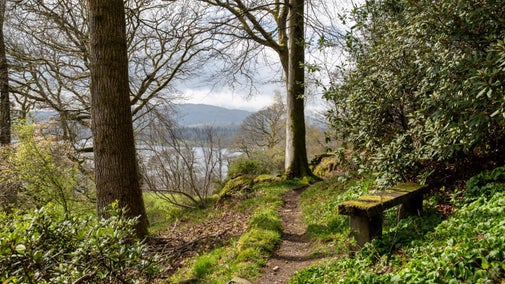
Donate
Everyone needs nature, now more than ever. Donate today and you could help people and nature to thrive at the places we care for.

Once housing a cohort of 500 fierce infantrymen, Ambleside Roman Fort was built on the shores of Lake Windermere when Cumbria was a land of mountainous warfare, almost 2,000 years ago. Now, the beautifully situated remains are in urgent need of protecting. Find out about exactly what we’ve done to do so.
In recent summers, teams of volunteers, conservation builders and archaeologists have been working hard to protect and strengthen the above-ground remains of the fort.
The work has involved removing the turf capping from the low walls of the fort, raking out earth from between stones, and applying lime-rich mortar to create a hard-wearing and protective cap.
As a result of this effort 175 metres of exposed stone walling was consolidated on the Commander's House, Headquarters Building and Main Gateway.
During the work the team found over 2,000 archaeological finds, which were subjected to expert analysis and compiled in a report. The objects were then deposited in the Armitt Museum in Ambleside which holds the archives from the excavations undertaken in the early 20th century.
One of the most exciting aspects of the project was the opportunity to undertake a geophysical survey of the fort and the surrounding area to look for evidence of buried, and often unrecorded, archaeological remains.
The geophysical survey gave volunteers an opportunity to try their hand at three different types of survey: magnetometry, resistivity and ground-penetrating radar.
The results from these surveys highlighted evidence of intact building remains – presumably barracks – in the unexcavated part of the fort, as well as the existence of roads, drains and rubbish pits.

To the north of the fort the survey identified a previously unrecognised building which might be the Roman baths, while to the south-east the remains of a road flanked by buildings might be the remains of the civilian settlement or ‘vicus’ that stood in the shadow of the fort.
Ground-penetrating radar also provided a glimpse of the late first century Roman fort which occupied the same site as the existing fort, founded in the early second century.
Attention then turned to improving physical access to the fort by means of introducing a new gate linking the site with the adjacent park owned and managed by South Lakeland District Council.
This new gate allows pushchairs and buggies to attain access onto the site for the first time and is also suitable for anyone using a mobility scooter.
The final phase of the project focused on the design and installation of a new interpretation scheme to inform visitors on the site. As part of this the old interpretation panels were removed and bigger, brighter panels installed at key locations across the site.
In addition to the on-site information, a new site guide was written to provide further information for those wishing to learn more about the Roman Fort: the leaflet is free and available from Armitt Museum in Ambleside.
Ambleside Roman Fort is open every day, year round. We look forward to welcoming you.

Everyone needs nature, now more than ever. Donate today and you could help people and nature to thrive at the places we care for.
Find out more about the history of Ambleside Roman Fort, Dora’s Field and the 17th-century Bridge House.

Make the most of the lakeshore paths next to Windermere, lofty peaks and ancient woodlands in Ambleside with these recommended walks. Step back in time at the Roman fort and 17th-century Bridge House.

Read about our strategy, which focuses on restoring nature, ending unequal access and inspiring more people.

We believe that nature, beauty and history are for everyone. That’s why we’re supporting wildlife, protecting historic sites and more. Find out about our work.
